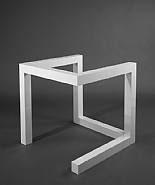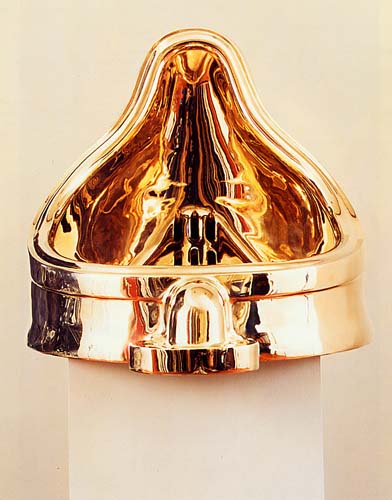
 Two of many Sol LeWitt's incomplete Cubes
Two of many Sol LeWitt's incomplete Cubes
 Bruce Nauman's Run from Fear Fun from Rear in neon
Bruce Nauman's Run from Fear Fun from Rear in neon
60s and 70s: Systems and ExperimentsThe work from the 60s and 70s is, in general, of great importance to what I make and do, and I think about it frequently. And as I always do, I think about the public's reaction to these sorts of pieces, although Bruce Nauman says repeatedly that he makes art for the few--not the elite--but that his art is something he'd want to show a friend, for example. Though Nauman is quite confident, I am not and I am insecure about the public eye, what they think (MAKE ME THINK). I want to preface by saying my thoughts on this matter are founded upon the assumption that the "general public" (whatever that means) sees these pieces as tasteless or simply as not being art (which actually is a very astute observation, if people don't just shut down when looking at something "modern" or contemporary and find it to be a little odd--for sake of simplicity right now, I am going to ignore this and bring this up in an article about Duchamp sometime later. This issue is not my primary concern).
I believe that the work seen above ought to be seen differently than other forms of art--I think it ought to be judged by different criteria. The work is not about aesthetics. What I mean when I say this is that there is no one aesthetic that determines or creates the piece. Instead it other systems, which an artist uses to execute an idea or action (or in this case, which someone else executes... see my first brief article "end of the beginning"). It's literally experimentation; it's experimental art. In the case of Sol LeWitt, the system is obvious when you see a great amount of his work. With the open, incomplete cubes, I believe that Sol LeWitt made every combination of an open cube available. If I am incorrect, he still 'made' many incomplete cubes. He experimented within a specific framework and saw the results of following that system.
Perhaps the viewer feels cheated, believes that the all the cubes are complete worthless based on the absence of an aesthetic system which determines the appearance of the piece (again, this is not to say there is not an aesthetic to the piece or that appearances are not important to the artist). To reiterate, I believe that this individual looks at the work from a slightly flawed perspective. To say that experimental art is bad is like saying a scientific experiment is bad. Or even more bazaar, to choose say you prefer one cube over another. That would be like asking, "which scientific experiment involving rats in mazes and mental cognition do you prefer?"
This question, "which scientific experiment involving rats in mazes and mental cognition do you prefer?," appears odd to us. I am arguing that odd reaction is the same regarding experimental art. At this point I would like to clarify a couple of things. Of course, is that you can prefer anything over anything else and judge biasedly. For example, you could prefer the scientific experiment that has a gray rat because you like gray rats. In this sense, no reaction is bazaar. You feel and think what you feel and think. At the same time though, this gives no consideration to anything except your own opinion, which is what you could say I am attacking: no consideration.
So if you 'cannot' judge based on an aesthetic system, what system do you judge it by? Well, an experimental system. That is what is important, the experiment. In short, if you don't see it this way, you are seeing it incorrectly.
Questioning Perceptions...But can this really be a true statement? Can I or anyone else say that your perspective is wrong? Could I or someone else say that a person is visually illiterate? This is confusing for me. I personally believe that, yes, I can say that people see things incorrectly and that a piece does have an inherent logic.
But then i turn around and say, but art is not just what is in the head of the maker but also in the eyes of the viewer (though Rachel, www.statetheproblem.blogspot.com , has made a very good point to me that ultimately the artist, not the audience, is the only reason for art being made--I agree, but again I am more insecure and concerned about public opinion). Though I firmly believe one can see things incorrectly, I have no proof or valid foundation. In fact, I can only say that the opposing argument, that art is primarily if not completely interpreted by the viewer, has more evidence. This entire conversation inevitably addresses the question, "what is art?," and the common response, "these complexities of what art is and how art is seen makes it art."
I am skeptical of this. Challenging "what is art" is not a valid way to make art. Philosophers and theologians have challenged art making, but that doesn't make their argumentation or writings art to the general public or even the art work, does it? Obviously not.
One philosopher, Arthur Danto, to tackle the question, "what is art?," defined art as whatever the art world accepts as art. But what if an object was once considered art, but is no longer? What of Byzantium? Those "artists" were considered craftsmen! Who are we to retroactively claim these people as artists when their own contemporaries did not? On the other hand, does it matter if it is the same creative spark, which is shared across cultures? Is a child's or a scientist's drawing not art because it isn't accepted into the cannon?
In short, I question questions and doubt doubts. And furthermore, I don't know.







